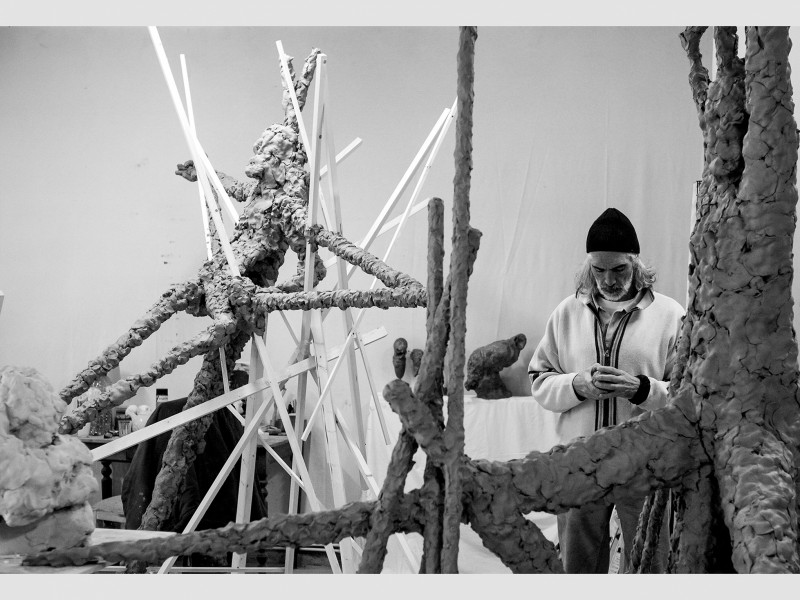Saint Auxelius’s head rests delicately upon an embroidered pillow, his face veiled in diaphanous muslin, one hand poised contemplatively against his cheek. His costume of elaborate gold filigree is decorated with precious jewels: rubies, sapphires, diamonds and pearls anoint his reclining form, from the pinnacle of his headdress to the tips of his slippered feet. That the saint has been dead for over 1000 years only compounds the strange, theatrical beauty of the spectacle, his creamy skull and the deep recessions of his nose and eye sockets providing ghostly contrast with the gaudy splendour of his adornments. Enclosed and exhibited in his elaborate glass tomb, his recumbent body incongruously juxtaposes the exquisite and the grotesque, part sleeping beauty, part grim reaper.
The story of Saint Auxelius and his lifeless brethren, the catacomb saints of Northern Europe, is a peculiar one, embedded in the post-Reformation crisis of faith that prompted a dramatic return to decorative materialism in practices of worship. Examined for the first time in a lavishly illustrated volume by art historian Paul Koudounaris, these holy bodies emerge as symbols of that most curious mingling of the corporeal and the metaphysical which characterises the relic tradition. Koudounaris traces the complex history of these figures, collected and reimagined with the explicit purpose of filling a spiritual, emotional and physical gap left by the Protestant Reformation purge of the Catholic Church’s most beloved icons. After countless formally sanctified relics were destroyed over the course of the 16th century, the need to source appropriate replacements led church officials literally underground, to the recently discovered ancient burial chambers beneath Rome, where the interred bodies of persecuted Christians had, for centuries, remained undisturbed.
The saints’ ambiguous status is further complicated by the fact that they were not, in any traditional or official sense, sainted. Transported across the Alps from Italy into German-speaking regions of Europe from the mid-1500s, their arrivals peaking in the 17th and 18th centuries, the catacomb saints were, in the vast majority of cases, the bodies of unknown people. Their internment dated from the early Christian era, and although lacking verifiable means of identification, the remains were widely believed to have been those of martyrs who sacrificed their lives rather than relinquish their faith. As such, while not formally beatified, nor, in the majority of cases, in any way actually connected to the saintly identities they were assigned, they were perceived nonetheless as legitimate conduits of the Holy Spirit. In order to differentiate these more informally sanctified bodies from those that had been officially designated by the Pope, they were collectively entitled the Katakombenheiligen (catacomb saints).
The process of conversion from decaying skeleton to ornamented icon, enthroned and enshrined, was a complex and protracted one, requiring the participation of numerous skilled workers, in many cases nuns specially trained in the preparation of relics. The most expert of these were the Dominican sisters in Ennetach in Southern Germany, who executed all aspects of a saint’s transformation, from the stabilisation of the skeleton itself to the application of decorative textiles. Upon arrival at the monastery, the condition of the bones would be assessed and those deemed sufficiently durable for more complex articulation and decoration would then begin their lengthy preparation for display. After the application of a stabilising animal glue, the bones were, depending upon their condition, set with wire, wrapped with gauze, and frequently reconstructed with wax, wood, or papier-mâché. The application of precious stones, (or in the cases of less affluent religious houses, their paste equivalents) was frequently undertaken by secular craftspeople experienced in working with metals and gems. After a saint’s official ‘translation’, he or she would be carried through the town and installed in a conspicuous position in the church, usually in a correspondingly lavish shrine or upon an altar or predella.
Saint Valerius, housed in the Augustinian monastery at Weyern, is an exemplar of the excesses of theatricality and ornament that characterize the Katakombenheiligen. Adorned from head to toe in precious gemstones, rich textiles and goldwork, and crowned with a golden diadem, his visage is lent an incongruous liveliness by the addition of sparkling blue sapphires in place of the eyes, lidded with delicate folds of muslin. The saint’s teeth are physically and symbolically recreated in disks of tiny, delicately woven pearls. His exposed ribcage is threaded with matching strings of pearls, and teardrop rubies nestle at his throat. That the skeleton itself is not so much concealed but augmented by the decoration is in itself significant. There is, inherent in these constructions, the tradition of memento mori, the symbolic, evocative juxtaposition of glory and decay that serves as a reminder of human mortality and the fleetingness of material existence.
The status of the catacomb saints was, from the outset, politically charged, even propagandistic. They symbolised, in their newly appointed splendour, the defiant resurgence of a Catholic Church determined to visibly reassert its traditional practices of worship. In keeping with their revolutionary status, many of the saints associated attributes seem surprisingly militaristic. Swords were among the most popular of these, and Koudounaris identifies a dual meaning in their inclusion, ‘referring to the saint’s own martyrdom, but also identifying the skeleton as a Miles Christi, or Soldier of Christ, risen and armed for battle.’1 Accordingly, costumes feature breastplates, tassets, gauntlets, and a profusion of abundantly jewelled helmets, often complete with visors theatrically raised to reveal the skull below. These elements, rendered not in steel but in the most luxurious gold threads, silks, filigree and gemstones, are both threatening and seductive, markers of material wealth and spiritual rebellion.
Despite the artifice inherent in their construction and the absence of traditional consecration, these bodies operated, both spiritually and culturally, in the role of the relics they replaced, and rituals of public display and celebration were integral to this. To this day, in the town of Roggenburg in rural Bavaria, the bones of Saints Severina, Valeria, Laurentia and Venantius are each year removed from their richly decorated crypts in the former Norbertine monastery church, placed on litters, decorated with flowers, and carried down the nave and around the church upon the shoulders of local teenagers. The ritual, known as a Lieberfest, has been enacted by the townspeople for over 200 years, functioning as a gesture of thanks to these beloved icons for their centuries of service to the congregation, as well as for their imagined martyrly sacrifice. Roggenburg’s saints are among the more extraordinary of their kind. By the 19th century, after the initial excitement about their arrival had waned, the inescapable corporeality of their forms proved too confronting for some members of the local congregation. To assuage discomfort around such manifest reminders of mortality, the skulls were fitted with papier-mâché masks painted in imagined likenesses of the living saints, an effect which, to a 21st century spectator, only compounds the eeriness of the spectacle.
Inherent within the relic tradition is the notion that these artefacts are, in a sense, active; that their spiritual agency extends beyond the realm of inspiration, and into that of the tangible. Accordingly, the catacomb saints gained much of their status through accounts of their associated miracles. At the Capuchin convent in Stans, Germany, the newly arrived bones of Saint Prosper were immediately credited with the miraculous healing of the mother superior, who had, according to accounts, been suffering from a fever that broke on the day that the skeleton was received. Such events endowed the relics, and their associated religious houses, with significant status, and led to the designation of the bones as those of a ‘healing saint’ to whom the local populace might subsequently appeal for cures of their own. Tales of miracles attributed to a martyr’s bones were kept in ‘miracle books’, which faithfully recorded the alleviation of ailments, from foot pain to incontinence to nosebleeds. The saints were also widely perceived to have powers of divine intersession in natural events: Saint Donatus of Detzem, Germany, was regularly called upon to protect the local populace from lightning strikes, having earlier been credited with saving the life of a priest who was, somewhat ironically, struck during preparations for the saint’s procession into the city.
Their great popularity among congregations meant that many churches and monasteries acquired large collections of saints, functioning not only as a source of spiritual succour to local people, but also as a means of income generated by visiting pilgrims. Regular donations made to the church in the saints’ honour designated their worldly value in addition to their more spiritually elevated role. Worshippers could also make more personal donations in the form of jewellery or other valuable ornaments, which would be added to the saint’s body or shrine. Rings were a particularly popular choice, and many saints’ hands grew crowded with these material manifestations of their devotees’ spiritual fervour.
Yet such devotions have never been without controversy. The relic tradition has always been a fraught one, coloured by anxiety about idolatry and framed, in Protestant terms, within the regrettable Catholic propensity for materialism and false worship. Even within the Catholic Church itself, the relationship with relics has been ambivalent. Relics could be used as devotional aids, but should never, it was decreed, be perceived as having their own power distinct from that of the deity. The distinction between veneration and worship was not always clearly defined or agreed upon, however. Anxieties surrounding the superstitious nature of some acts of devotion were ultimately attached to the catacomb saints, as they had been to the original relics destroyed in the Reformation spirit of pious austerity. Criticism was amplified by suggestions that the creation of the saints was, in effect, an act of calculated and perhaps mercenary fraud. The 18th century protestant bishop Gilbert Burnet declared that ‘the Bones of Roman Slaves … are now set in silver and gold with a great deal of other costly Garniture, and entertain the superstition of those who are willing to be deceived.’2
That the popularity of the saints waned as swiftly and dramatically as it arose is again testament to their highly emotive quality. As the 18th century gave way to the nineteenth, accusations of materialism and idolatry intensified, and the jewel-encrusted skeletons came increasingly to be perceived as potent and disquieting symbols of the Catholic Church’s capacity for morbidity and decadence. Many were actively destroyed or buried in anonymous plots. Some were simply removed from public view, secreted in crypts or vaults where they would not attract attention or censure. Others were sold to private collectors or museums, whether as private devotional aids, or as curiosities akin to the two-headed calf or preserved foetus in a jar.
Yet in isolated pockets of German-speaking Europe, affection for the saints persisted. A case study in this continuing attachment exists in the town of Rottenuch in Bavaria, where in 1803, the secular magistrate had elected to auction the town’s two saints. Their locations remained known, however, and in 1977, 174 years after the saints were sold, the townspeople raised sufficient funds to have them returned. To this day, Saints Primus and Felicianus continue to be publicly honoured in all of their disquieting, extravagant glory.
Those saints that survive intact exist not only as objects of extraordinary craftsmanship and uncanny fascination, but as inescapably physical reminders of the church’s complex, emotionally and politically charged vacillations between austerity and materialism, authenticity and artifice. They remain potent, fantastic markers of the obsessive corporeality and mysticism of the relic tradition, infused with the spirit, and fashioned of the flesh.
Footnotes:
Paul Koudounaris, 2013. Heavenly bodies: cult treasures & spectacular saints from the catacombs. p. 85.
G Burnet, 1750. Bishop Burnet’s Travels through France, Italy, Germany, and Switzerland: Describing their religion, learning, government, customs, natural history, trade, &c. London: Printed for T. Payne, in Koudounaris, p. 57.
Related Features
-
74
-
-
-

